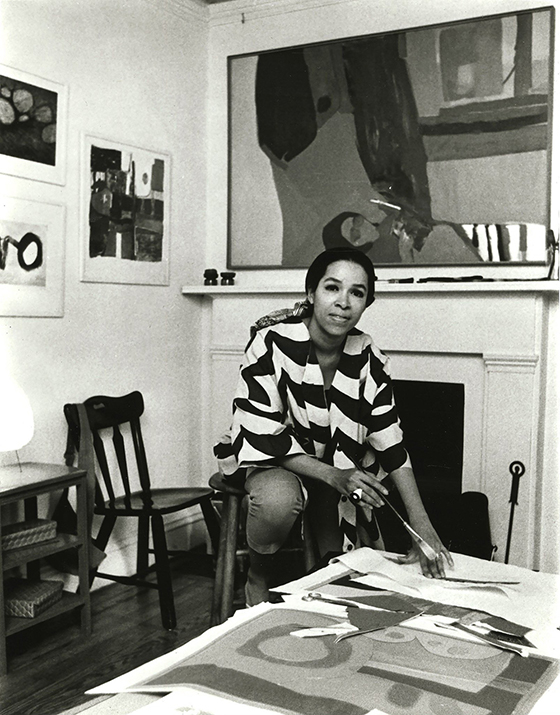Emma Amos was a painter, printmaker, and weaver who sought to disrupt white and male artistic and social conventions through her art and activism. Increased interest in the Black Arts movement of the 1960s and ’70s has called attention to Amos as the only woman (and youngest) member of the New York City artists’ collective known as Spiral (1963–1970s), a forum for Black artists to discuss their role in the country’s rapidly changing political and cultural landscape. Amos later noted that some of her male counterparts “weren’t comfortable with women artists as colleagues” and suggested that she may have been invited to join, in part, because of her youth (as she may have appeared less threatening than more-experienced women artists such as Camille Billops or Faith Ringgold). Despite her inclusion in this groundbreaking collective, Amos, like many of her female peers, had a circuitous career, facing both racial and gender prejudice in her efforts to work, as well as to create, show, and sell her art.

Emma Amos, 1967. Art International Archive, Department of Image Collections, National Gallery of Art Library, Washington. Photo: Moneta Sleet, Jr.
Amos grew up in Atlanta, then earned a BA from Antioch University (Ohio) and a degree in etching from the London Central School of Art. In 1960 she moved to New York, where she made prints in the workshop of legendary printmaker Robert Blackburn, worked for the textile designer Dorothy Liebes, and received her master’s degree in art education from New York University. She taught at various schools and cohosted a television craft show before securing a professorship at Rutgers University in 1980.
Amos also contributed to the feminist art journal Heresies and is known to have participated in the Guerrilla Girls activist group of anonymous women artists who protest injustices in the art world. Her work has gained attention in recent years, appearing in the major touring exhibitions Soul of a Nation: Art in the Age of Black Power (Tate Modern, London) and We Wanted a Revolution: Black Radical Women (Brooklyn Museum), both of which opened in 2017. A major retrospective of her work is scheduled to open at the Georgia Museum of Art in 2021.
The National Gallery of Art recently acquired five works on paper by Amos, significantly enhancing our representation of her work. (See Mel Harper’s post featuring the screenprint Gold Face Type.) I have been intrigued by her compelling images of Black figures portrayed in a range of colors and compositions and by her inventive use of materials and mixing of media since I first encountered her work. And I am particularly fascinated by her continual engagement with feminist and racial concerns and power dynamics, even in work that may not appear overtly political.

Emma Amos, Pool Lady, 1980, etching, aquatint and stencil, Gift of the Collectors Committee, 2019.164.3
Amos’s etching Pool Lady, 1980, pays homage to the “bather” subject found throughout the history of art, from prehistoric figurines to the contemporary photographs of Rineke Dijkstra. Featuring a Black woman (likely a self-portrait)—rarely seen in portrayals of “bathers” in Western art—Pool Lady stands as a form of social commentary in itself. This confident figure with her fist on her hip, wearing a boldly pattered swimsuit, locks the viewer in a powerful gaze, fully in charge of her presence. Amos’s skill as a printmaker and her experience as a weaver and textile designer are evident in the masterful handling of the rich tones of brown aquatint and the contrasting textures. The forthrightness of this bather, and the enticing material qualities of this etching, may be seen as a visual manifestation of civil rights and women’s movement mantras such as “Black is beautiful” and “The personal is political”: an assertion of Black female empowerment.
Emma Amos died on May 20, 2020, yet her stated mission—to “dislodge, question, and tweak prejudices, rules, and notions relating to art and who makes it, poses for it, shows it, and buys it”—resonates anew in our current historic moment. Amos’s paintings, prints, and mixed-media works will continue to inspire us to look closely and question what we see, challenging our assumptions and changing our conversations to foster better understanding of each other—and ourselves.